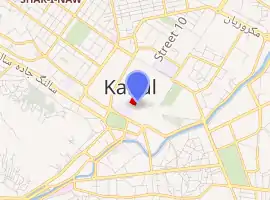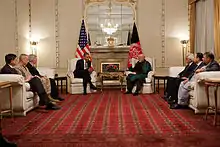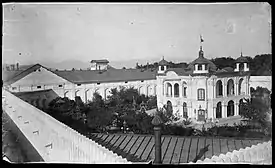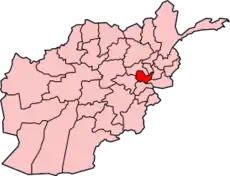Arg (Kabul)
The Arg (Pashto: ارګ; Persian: ارگ; meaning "citadel") serves as the presidential palace in Kabul, Afghanistan.[1] It sits on a 34-hectare (83-acre) site in District 2, between Deh Afghanan and the affluent neighbourhood of Wazir Akbar Khan. The Arg was built after the destruction of the Bala Hissar in 1880 by the British Indian troops. It has been used by many Afghan kings and presidents, from Emir Abdur Rahman Khan to current President Ashraf Ghani.
| Presidential Citadel (Arg) | |
|---|---|
.jpg.webp) Front of the palace in February 2020 | |

| |
| General information | |
| Town or city | Kabul |
| Country | Afghanistan |
| Construction started | 1880 |
| Technical details | |
| Structural system | Afghan |
| Size | Approximately 34 ha (83 acres) |
History
The foundation of the Arg was laid by Emir Abdur Rahman Khan in 1880 after assuming the throne. It was designed as a castle with water-filled trench around it. Abdur Rahman Khan named it Arg-e-Shahi (Citadel of the King) and included among other buildings a residence for his family, army barracks, and the national treasury. Previously, the Bala Hissar served as the citadel or the headquarters of the emirs until it was destroyed by the British Indian troops during the Second Anglo-Afghan war (1878–80).
The Arg has served as the royal and presidential palace for all of the kings and presidents of Afghanistan. However, Hafizullah Amin also used Tajbeg Palace as the residence for his family. It has undergone modifications and revitalization under the different rulers. During the 1978 Saur Revolution, Mohammed Daoud Khan and his family were assassinated by members of the People's Democratic Party of Afghanistan (PDPA) inside the Arg.
The Arg today consists of the following:
- The Gul Khana which serves as the offices for President Ashraf Ghani and the President's Protocol Office;
- The Offices of the President's Chief of Staff;
- The National Security Advisor's building; and the Offices of the Spokesperson to the President.
- Offices for the Afghan National Security Forces (ANSF).
- Building for the Administrative Office of the President.
- Various buildings for receiving delegations or hosting large meetings.
Gallery
.jpg.webp) The front of the palace on February 29, 2020
The front of the palace on February 29, 2020.jpg.webp) NATO and Afghan officials in 2020
NATO and Afghan officials in 2020.jpg.webp)
.jpg.webp) Overview of the palace and the Pashtunistan neighborhood
Overview of the palace and the Pashtunistan neighborhood.jpg.webp) Overview of the palace and the Pashtunistan neighborhood
Overview of the palace and the Pashtunistan neighborhood Former U.S. President Barack Obama and former Afghan President Hamid Karzai during the May 2012 US-Afghan strategic agreement signing
Former U.S. President Barack Obama and former Afghan President Hamid Karzai during the May 2012 US-Afghan strategic agreement signing Former U.S. Defense Secretary Robert M. Gates and Karzai addressing international media in 2011
Former U.S. Defense Secretary Robert M. Gates and Karzai addressing international media in 2011 Karzai and Robert Gates in 2010
Karzai and Robert Gates in 2010 The Arg entrance in 1965
The Arg entrance in 1965 The palace when first built in the 1890s, during the reign of Amir Abdur Rahman Khan
The palace when first built in the 1890s, during the reign of Amir Abdur Rahman Khan
References
| Wikimedia Commons has media related to Arg (Kabul). |
- "Archived copy". Archived from the original on 2012-09-05. Retrieved 2012-09-04.CS1 maint: archived copy as title (link)
See also
Other Palaces in Kabul:
- Bagh-e Bala, a former royal palace in Kabul
- Bala Hissar, an ancient fortress located in the south of the old city of Kabul,
- Darul Aman, former royal palace
- Herat Citadel, former main royal palace
- Tajbeg Palace, former royal palace

